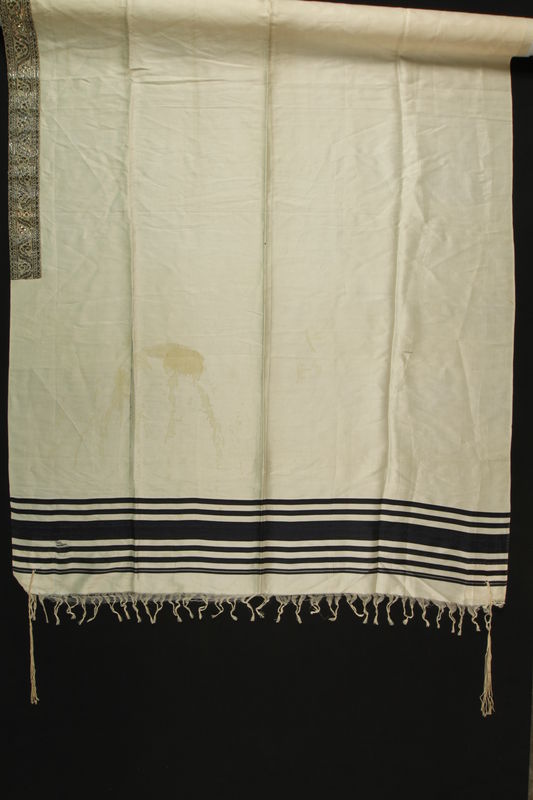Overview
- Brief Narrative
- Tallit or prayer shawl buried for safekeeping by Johanna Baruch Boas while she lived in hiding in Brussels, Belgium, from 1942-1944. The tallit was worn by her husband, Bernhard, during religious services. Bernhard died in Berlin, Germany, in 1932. She brought it with her when she fled Nazi Germany for Brussels in March 1939 with her daughter’s family. Germany occupied Belgium in May 1940 and soon there were frequent deportations of Jews to concentration camps. Johanna had a non-Jewish landlady who hid her in her attic. In December 1944, a few months after the liberation of Belgium, Johanna was reunited with her 11 year old niece, Beatrice Westheimer, who had been placed in hiding in a small country village. Her mother, Johanna's daughter, and her father, as well as a paternal uncle, had been killed at Auschwitz. Johanna and Beatrice joined family members in the United States in 1946.
- Date
-
use:
before 1932
recovered: after 1944 December
- Geography
-
recovery:
buried for safekeeping;
Brussels (Belgium)
- Credit Line
- United States Holocaust Memorial Museum Collection, Gift of Beatrice Muchman
- Contributor
-
Subject:
Beatrice Muchman
Original owner: Bernhard Boas
Subject: Johanna Boas
- Biography
-
Beatrice (Trixie) Westheimer was born on June 5, 1933, in Berlin, Germany, the only child of Julius and Meta Boas Westheimer. Meta was born in 1904 to Orthodox Jewish parents, Bernhard (d. 1932) and Johanna Baruch Boas, and had three sisters, Hella, Margot, and Frieda. In 1933, Hitler became Chancellor of Germany and throughout the 1930s the persecution of Jews became increasingly punitive and violent. In March 1939, Beatrice’s family, including her maternal grandmother, Johanna, and her maternal aunt, Margot Lewy, and her husband, Werner, and son, Bernt, escaped to Brussels, Belgium. They were smuggled across the border with the assistance of two men hired as guides by her father and uncle. They joined her mother’s oldest sister and her family, Frieda, Walter, and Henri Hurwitz, who lived in Ukkle. Her mother had one other sister, Hella Tausk, who with her husband, Walter, had immigrated to the United States earlier in the 1930s. In December 1939, the Lewy family received permission to immigrate to the US and they left for New York.
Germany conquered Belgium in May 1940 and immediately enacted anti-Jewish legislation. On May 10, 1940, the Germans arrested Beatrice’s father, Julius, and her uncle Walter. Julius was sent to Camp Agde near Montpelier, France, and later to Rivesaltes internment camp. In February 1941, he escaped from the camp and returned to his family in Belgium. Walter was sent to Gurs internment camp in France and on August 6, 1942, was deported to Auschwitz, where he was killed. In July 1942, Beatrice and her cousin Henri were told by their parents that they were going on vacation. Her father took them to the village of Ottignies to live with two Catholic sisters, Jeanne and Adele Duchet. Jeanne explained to Beatrice and Henri that their last name would now be Duchet. The villagers were told that they were Jeanne's niece and nephew. Her father was able to visit once, in the fall of 1942, when he brought the rest of their belongings and worked out the longterm living arrangements for Beatrice and Henri. The children were baptized as Catholics on October 2, 1942. The priest, Father Vass, knew of the children’s situation and helped keep them safe in the village.
In February 1943, Beatrice’s parents were arrested and sent to the Mechelen ( Malines) transit camp in Belgium. They were soon loaded onto transport XX for Auschwitz concentration camp. They were involved in an escape plan organized by the Belgian resistance. Most of the escapees were gunned down by the German guards. Beatrice's father was shot and eventually died in a nearby home. Her mother was sent to a hospital where she was denounced and recaptured and, on February 26, deported to Auschwitz, where she was killed. Her grandmother and her aunt Frida were able to avoid deportations because their non-Jewish landlady helped them live in hiding in her attic.
Belgium was liberated by Allied Forces in September 1944. That December, Beatrice and Henri returned to Brussels to live with their grandmother and Henri’s mother. In May 1946, Beatrice and her grandmother immigrated to the United States, where Beatrice was adopted by her aunt and uncle, Margot and Werner Lewy. Beatrice became a teacher. After her adoptive father, Werner Lewy died, age 85, on June 12, 1990, Beatrice learned many details about her past in papers that he had saved. Beatrice had always felt that her parents abandoned her, and she had kept a diary during the war, but now she could understand her history more clearly. In 1997, she wrote a memoir of her experience, Never to Be Forgotten: A Young Girl's Holocaust Memoir.
Johanna Baruch was born in Berlin, Germany. She had three brothers, Adolf, Benno, and Richard. She married Bernard Boas. The couple ran a publishing company in Berlin which specialized in Jewish prayer books. They had four daughters, Hella, Frida, Margot, and Meta, and were a traditionally orthodox, comfortably middle-class Jewish family. All the girls were raised to be independent and were trained in a profession. Bernard died of natural causes in 1932. In 1933, Hitler became Chancellor of Germany and throughout the 1930s the persecution of Jews in Germany became increasingly punitive and violent. In March 1939, Johanna escaped Germany with two of her daughters, Margot Lewy and Meta Westheimer, and their families to Belgium. They were smuggled across the border with the assistance of two men hired as guides by her sons-in-law, Julius Westheimer and Werner Lewy. They joined her eldest daughter and her family, Frieda, Walter, and Henri Hurwitz, who lived in Ukkle, Belgium. Her remaining daughter, Hella Tausk, had immigrated with her husband, Walter, to the United States earlier in the 1930s. In December 1939, the Lewy family received permission to emigrate to the US and they left for New York. Both families in the United States worked to obtain immigration visas for their relatives in Europe.
Nazi Germany conquered Belgium in May 1940 and immediately enacted anti-Jewish legislation. On May 10, 1940, the Germans arrested Julius and Walter. Julius was sent to Camp Agde near Montpelier, France, and later to the Rivesaltes internment camp. In February 1941, he escaped and returned to his family in Belgium. Walter was sent to Gurs internment camp in France. On August 6, 1942, he was deported to Auschwitz, where he was killed. In July 1942, Johanna's grandchildren, Beatrice Westheimer and Henri Hurwitz, were told by their parents that they were going on vacation. Beatrice's father took them to the village of Ottignies to live with two Catholic sisters, Jeanne and Adele Duchet. He was able to visit once, in the fall of 1942, when he brought them the rest of their belongings. During this time, Johanna moved about, living with each of her daughters for several months at a time. In February 1943, Julius and Meta were arrested and sent to the Mechelen (Malines) transit camp in Belgium. They were soon loaded onto transport XX for Auschwitz concentration camp. They were part of an escape attempt planned by the Belgium resistance. Most of the escapees, including Julius, were gunned down by the German guards. Julius was taken to a nearby home where he died. His wife was with him and she was later taken to a hospital where she was denounced, rearrested, and on February 26, deported to Auschwitz, where she was killed. Johanna and Frida were able to avoid deportation because their non-Jewish landlady helped them live in hiding in her attic.
Belgium was liberated by Allied Forces in September 1944. That December, Beatrice and Henri returned to Brussels to live with Johanna and Henri’s mother. In May 1946, Johanna and Beatrice immigrated to the United States, where they were reunited with family members.
Physical Details
- Classification
-
Jewish Art and Symbolism
- Category
-
Jewish ceremonial objects
- Object Type
-
Tallitot (Jewish liturgical objects) (lcsh)
- Physical Description
- Long, rectangular, offwhite cloth prayer shawl with 6 dark blue stripes and long, knotted fringe on each end. There is a small, decorative, silver metallic woven atarah [neckband] sewn onto the top interior center edge. There are tzitzit, tassels made from specially knotted thread, through each reinforced corner.
- Dimensions
- overall: Height: 70.500 inches (179.07 cm) | Width: 36.750 inches (93.345 cm)
- Materials
- overall : cloth, thread
Rights & Restrictions
- Conditions on Access
- No restrictions on access
- Conditions on Use
- No restrictions on use
Keywords & Subjects
Administrative Notes
- Legal Status
- Permanent Collection
- Provenance
- The tallit was donated to the United States Holocaust Memorial Museum in 2007 by Beatrice Muchman, the granddaughter of Johanna Baruch Boas.
- Record last modified:
- 2022-08-22 14:56:14
- This page:
- https://collections.ushmm.org/search/catalog/irn35049
Also in This Collection
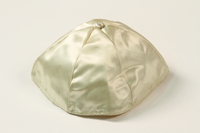
Kippah buried for safekeeping while the owner lived in hiding
Object
Yarmulke, a skullcap worn by observant Jewish males, buried for safekeeping with other religious items by Johanna Baruch Boas while she lived in hiding in Brussels, Belgium, from 1942-1944. It originally belonged to her husband, Bernhard, who died in Berlin, Germany, in 1932. She brought it with her when she fled Nazi Germany for Brussels in March 1939 with her daughter’s family. Germany occupied Belgium in May 1940 and soon there were frequent deportations of Jews to concentration camps. Johanna had a non-Jewish landlady who hid her in her attic. In December 1944, a few months after the liberation of Belgium, Johanna was reunited with her 11 year old niece, Beatrice Westheimer, who had been placed in hiding in a small country village. Her mother, Johanna's daughter, and her father, as well as a paternal uncle, had been killed at Auschwitz. Johanna and Beatrice joined family members in the United States in 1946.
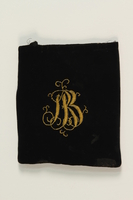
Black velvet embroidered tefillin bag buried for safekeeping while owner in hiding
Object
Black velvet pouch used to hold his tefillin, prayer boxes worn by Jewish males during morning prayer services, buried for safekeeping with other religious items by Johanna Baruch Boas while she lived in hiding in Brussels, Belgium, from 1942-1944. It originally belonged to her husband, Bernhard, who died in Berlin, Germany, in 1932. She brought it with her when she fled Nazi Germany for Brussels in March 1939 with her daughter’s family. Germany occupied Belgium in May 1940 and soon there were frequent deportations of Jews to concentration camps. Johanna had a non-Jewish landlady who hid her in her attic. In December 1944, a few months after the liberation of Belgium, Johanna was reunited with her 11 year old niece, Beatrice Westheimer, who had been placed in hiding in a small country village. Her mother, Johanna's daughter, and her father, as well as a paternal uncle, had been killed at Auschwitz. Johanna and Beatrice joined family members in the United States in 1946.
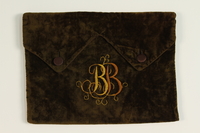
Green velvet monogrammed tallit pouch buried for safekeeping while owner in hiding
Object
Velvet tallit pouch buried for safekeeping with other religious items by Johanna Baruch Boas while she lived in hiding in Brussels, Belgium, from 1942-1944. A tallit is a prayer shawl worn by Jewish males for prayer services, It originally belonged to her husband, Bernhard, who died in Berlin, Germany, in 1932. She brought it with her when she fled Nazi Germany for Brussels in March 1939 with her daughter’s family. Germany occupied Belgium in May 1940 and soon there were frequent deportations of Jews to concentration camps. Johanna had a non-Jewish landlady who hid her in her attic. In December 1944, a few months after the liberation of Belgium, Johanna was reunited with her 11 year old niece, Beatrice Westheimer, who had been placed in hiding in a small country village. Her mother, Johanna's daughter, and her father, as well as a paternal uncle, had been killed at Auschwitz. Johanna and Beatrice joined family members in the United States in 1946.
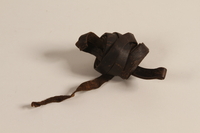
Set of tefillin buried for safekeeping while the owner lived in hiding
Object
Tefillin pair buried for safekeeping by Johanna Baruch Boas while she lived in hiding in Brussels, Belgium, from 1942-1944. They were used by her husband Bernhard who died in Berlin, Germany, in 1932. Tefillin are small boxes that contain prayers that are attached to leather straps and worn by Orthodox Jewish males during morning prayers. Johanna brought the tefillin with her when she fled Nazi Germany for Brussels in March 1939 with her daughter’s family. Germany occupied Belgium in May 1940 and by 1942 there were frequent deportations of Jews to concentration camps. Johanna had a non-Jewish landlady who hid her in her attic. In December 1944, a few months after the liberation of Belgium, Johanna was reunited with her 11 year old niece, Beatrice Westheimer, who had been placed in hiding in a small country village. Her mother, Johanna's daughter, and her father, as well as a paternal uncle, had been killed at Auschwitz. Johanna and Beatrice joined family members in the United States in 1946.
Torah
Object
Miniature Torah preserved by Johanna Baruch Boas while living in hiding in Brussels, Belgium. The Torah belonged to her husband, Bernhard, and was possibly used while traveling. Bernhard died in Berlin in 1932. Johanna carried it with her when she fled Nazi Germany for Brussels in March 1939, with her daughter’s family. The Germans occupied Belgium in May 1940 and enacted punitive anti-Jewish legislation. Soon they were deporting Jews to concentration camps. Johanna buried the yarmulke and other religious items to keep them safe during the occupation. Johanna survived with the help of her non-Jewish landlady who hid her in her attic. In December 1944, she was reunited with her 11 year old niece, Beatrice Westheimer, who had fled Germany with her. She had lived in hiding in a small village, but her parents and an uncle had been deported and killed at Auschwitz. Johanna and Beatrice immigrated to the United States in 1946.
Book
Object
Children's book, Der Struwwelpeter, read by 11year old Beatrice (Trixie) Westheimer when she was a hidden child in German occupied Belgium. It was originally written in 1945 and is a series of illustrated rhymes that tell fables about the unfortunate consequences that befall ill-behaved children. Trixie and her family fled Germany in 1939, joining relatives in Belgium. In May 1940, Germany occupied Belgium and in July 1942, the family went into hiding. Trixie and her cousin Henri were hidden on a farm and baptized as Catholics. In February1943, her parents Julius and Meta were deported; her father was shot during an escape attempt and her mother was killed in Auschwitz. In December 1944, Trixie and Henri returned to liberated Brussels. Trixie and her grandmother Johanna Boas emigrated to the United States in 1946.

